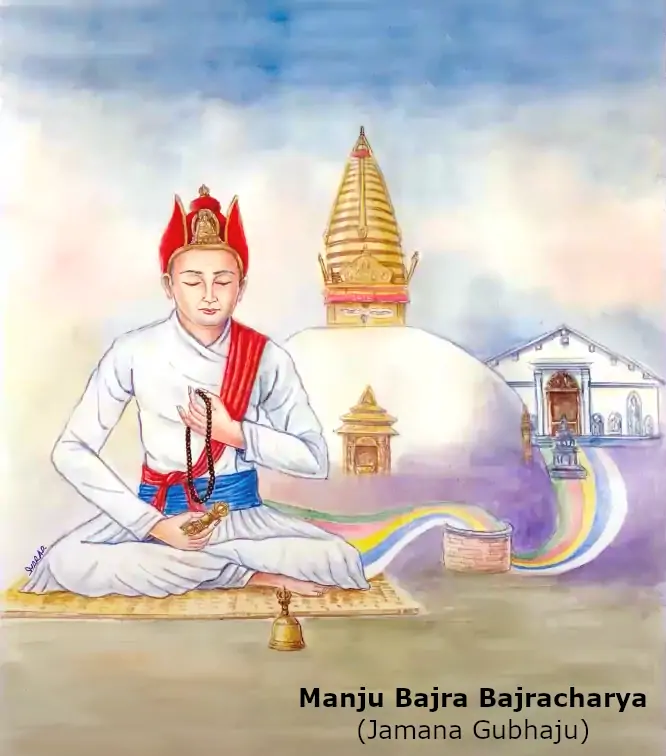Early Life and Historical Context
Manju Bajra Bajracharya, also spelled as Manju Vajra Vajracharya, in Sanskrit मञ्जु बज्र बज्राचार्य, widely known as Jamana Gubhaju (जा मन: गुभाजु), was a renowned Buddhist priest and Tantric master born in the 16th century during the Malla Dynasty, under the reign of King Pratap Malla (1641–1674 CE). He was from Musum Bahal ( See in Map), also called Manisingha Mahavihar, in Kathmandu, Nepal.
As an expert in Vajrayana Buddhism and Tantric practices, he earned the respect and trust of King Pratap Malla, serving as a close advisor and Buddhist Guru. Known for his wisdom and humility, his counsel was often sought by the king, highlighting his spiritual and intellectual significance.
Jamana Gubhaju’s life is filled with stories of compassion and service, including healing the sick and solving people’s problems, hallmarks of a true Bajracharya. He remains a celebrated figure, embodying the virtues of a spiritual guide and hero in Nepalese history.
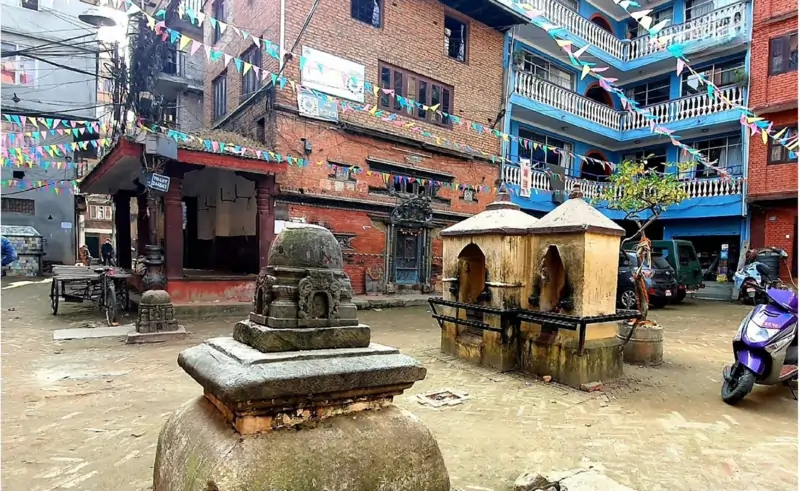
Why He Was Called “Jamana Gubhaju”
The name Jamana Gubhaju translates to “the priest who does not eat rice” in Newari. In the Newari language, Jamana (जा मन:, जा=Rice मन:=Does not eat) means “one who does not eat rice,” and Gubhaju (गुभाजु, गु=Guru/Priest भाजु=Married Person) refers to a married priest or Bajracharya. This title originates from a fascinating legend.
One day, Manju Bajra Bajracharya used his spiritual powers, or siddhi, to observe his wife cooking rice. To his shock, he saw her burning her own leg to fuel the fire. Deeply moved by this vision, he vowed never to eat rice again, considering it a sacred act of respect and empathy. This story underscores his asceticism and moral conviction, qualities that defined his extraordinary life.
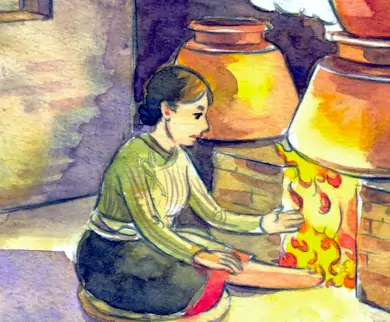
Credit: Surendra Maharjan
The Eagle and the Magician: A Tale of Power and Redemption
Long ago, in the bustling streets of Kathmandu near Maru Tole, a magician was performing his mesmerizing tricks. A crowd had gathered to watch him, marveling at his skills. However, their attention soon shifted when a man appeared, carrying water in a bamboo basket with holes (doko). Despite the impossibility of his task, water stayed inside the basket without spilling.
Curious and amazed, the spectators abandoned the magician’s performance and surrounded the man, eager to see the miracle. Enraged by the sudden loss of his audience, the magician threw a stone at the bamboo basket, causing the water to spill out completely. Satisfied, he turned back to his act, ready to impress the crowd once more.
As part of his next trick, the magician dramatically pulled a human heart out of his assistant. The audience gasped in astonishment. But before he could proceed, an eagle swooped down from the sky, snatched the heart from his hand, and soared away.
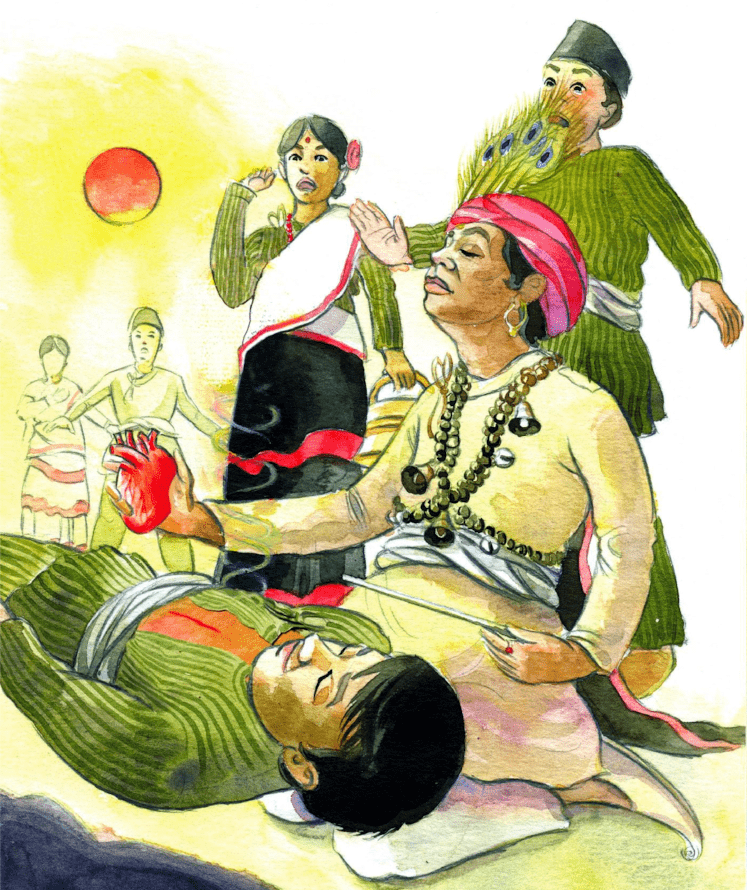
Credit: Surendra Maharjan
The magician was stunned. The restless crowd grew impatient, demanding that he finish the trick. Desperate, the magician confessed that he needed the heart back to complete the illusion.
From the crowd, an old man stepped forward and explained, “That wasn’t just any eagle but it was Jamana Gubhaju, a powerful and wise priest. He must have transformed into the eagle because you tampered with his work by leaking the bamboo basket. If you want the heart back, you must seek him out at his home in Musum Bahal”.
The magician, full of regret, rushed to Musum Bahal. When he arrived, Jamana Gubhaju was not there, but his wife was busy brewing alcohol. To the magician’s shock, she was using her own leg as fuel for the fire beneath the pot. Horrified and humbled, he asked her where he could find Jamana Gubhaju. She directed him to the banks of the Bishnumati River.
Near the river, the magician found Jamana Gubhaju performing another astonishing feat. He was feeding a goat while dragging a massive tree from the opposite bank of the river using just his foot. Trembling with shame and awe, the magician approached him and pleaded for forgiveness.
Jamana Gubhaju looked at him calmly and said, “You interfered with my work when you spilled the water from my bamboo basket. Why couldn’t you mind your own business?”
The magician, deeply remorseful, admitted his mistake. He promised never to harm or deceive anyone in Nepal again. Satisfied, Jamana Gubhaju agreed to return the heart. With a wave of his hand, the eagle returned, carrying the heart, which Jamana Gubhaju handed back to the magician.
The magician returned to Maru Tole, wiser and more humble. From that day forward, he kept his promise, performing his magic without malice or trickery. The story of the eagle and the magician became a timeless lesson, reminding everyone to respect others’ work and avoid interference in matters that do not concern them.
And so, the legend of Jamana Gubhaju and the magician lives on, teaching the values of humility, accountability, and redemption.
The Mystical Connection: Jyapu Well and Shantipur Temple
One of the most captivating legends surrounding Jamana Gubhaju involves his efforts to end a severe drought in Kathmandu. During this time, he sought the blessings of Naag Dev, the serpent deity, by descending into a well near his home, now known as the Jyapu Tu (ज्यापू तुँ , Jyapu Well) ( See in Map), also known as Bara Barse Inar (बार्ह वर्षे ईनार, 12 Years Well). As he meditated and prayed, he discovered a remarkable underground connection between the well and the Shantipur (शान्तिपुर) Temple ( See in Map) at Swoyambhu (स्वयम्भू ).
The Shantipur (शान्तिपुर) Temple, shrouded in mystery, is said to have seven enigmatic doors and multiple underground chambers. According to legend, only Jamana Gubhaju, with his mastery of siddhi (spiritual powers), could unlock all seven doors. This extraordinary feat remains unmatched, as it is believed to require unparalleled spiritual strength.
This tale not only highlights Jamana Gubhaju’s mystical abilities but also his devotion to helping his community. By connecting with divine forces through meditation and spiritual discipline, he symbolized the harmony between human effort and higher powers, leaving a legacy of awe-inspiring wisdom and compassion.
In honor of this legend, the people of Musum Bahal clean the Jyapu Well every 12 years as part of a ritual, preserving its sacred significance. This tradition is why the well is also called Bara Barse Inar (बार्ह वर्षे ईनार), serving as a reminder of Jamana Gubhaju’s extraordinary legacy. The well is enclosed by a protective wall to safeguard its historical heritage. Locals say that during the cleaning ritual, a doorway leading to a staircase into the basement is visible. However, no one has dared to venture inside, except for the legendary Jamana Gubhaju.
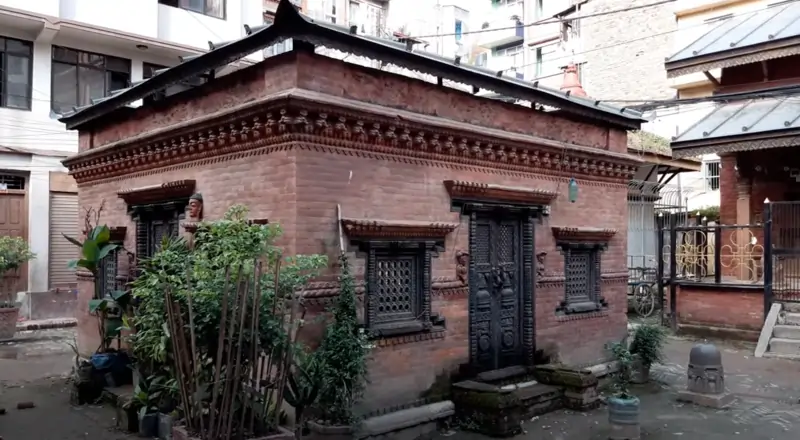
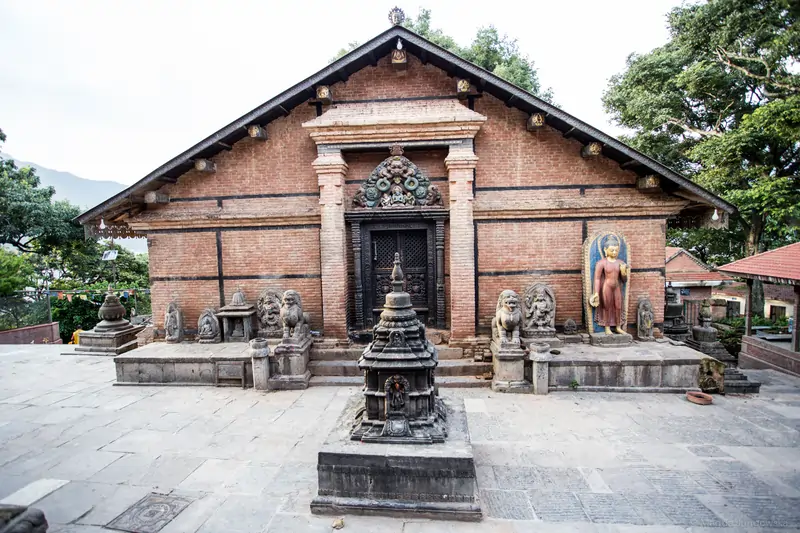
Literature and Texts Written by Manju Bajra Bajracharya
Manju Bajra Bajracharya, famously known as Jamana Gubhaju, authored profound texts in Sanskrit that reflect his mastery of Vajrayana Buddhism and Tantric practices. Below are the texts he composed, transliterated with their meanings:
- वज्रभैरव साधन नाम (Vajra Bhairava Sadhana Nama)
- Meaning: The Practice Manual of Vajra Bhairava
This text is a guide for the meditative and ritual practices of Vajra Bhairava, a fierce manifestation of Manjushri. It outlines methods for overcoming obstacles and cultivating wisdom through Tantric discipline.
- Meaning: The Practice Manual of Vajra Bhairava
- तारादेवी स्तोत्र एकविंशति साधन (Tara Devi Stotra Ekavimshati Sadhana)
- Meaning: The 21-Practice Hymn of Tara Devi
This hymn is dedicated to the 21 forms of Tara, the goddess of compassion. It serves as a devotional and meditative text for invoking her blessings for protection, guidance, and liberation.
- Meaning: The 21-Practice Hymn of Tara Devi
- महामुद्राभिगीति (Mahamudra Abhigiti)
- Meaning: The Supreme Song of the Great Seal
This is a poetic and philosophical exploration of Mahamudra, a central concept in Vajrayana Buddhism symbolizing ultimate realization and the union of wisdom and compassion.
- Meaning: The Supreme Song of the Great Seal
In addition to his texts, Jamana Gubhaju composed sacred songs, or Chacha (चचा), which are lyrical expressions of devotion and spiritual insight.
- नमामि (Namami)
- Meaning: I Bow Down
This song is a heartfelt offering of reverence and surrender to the divine, expressing humility and devotion in seeking blessings from higher powers.
- Meaning: I Bow Down
- श्री हारती (Shri Harati)
- Raga and Tala: Bhairavi Raga (भैरवी राग), Trihula Tala (त्रिहुला ताल)
- Meaning: A Hymn to Harati
Dedicated to the goddess Harati, this song praises her protective and nurturing qualities. Composed in the Bhairavi raga and set to the Trihula tala, its melody evokes a sense of devotion and serenity, resonating with spiritual seekers.
Jamana Gubhaju’s Final Journey: The Eternal Guardian
The story of Jamana Gubhaju’s departure from the physical world is as mystical as his life. One day, he entered a state of profound meditation in his Agam (prayer and meditation room) and instructed his wife not to open the door until he emerged. Days turned into nights, and when he still did not return, his anxious wife finally opened the door. To her astonishment, she found him in a lifeless state, with no pulse or heartbeat. Believing he had passed away, she performed his death rites according to the religious customs.
However, Jamana Gubhaju’s soul had not left. Instead, it remained in a deep meditative state, transcending the physical realm. When his soul returned, it found the body gone, leaving him without a physical form.
Even today, many in Kathmandu hold the belief that Jamana Gubhaju’s spirit continues to roam the city. As an unseen protector, his soul is said to safeguard the people and silently offer aid to those in need.
This enduring legend cements Jamana Gubhaju’s legacy as not just a spiritual master but an eternal guardian, whose presence is felt by those who believe in his timeless wisdom and compassion.
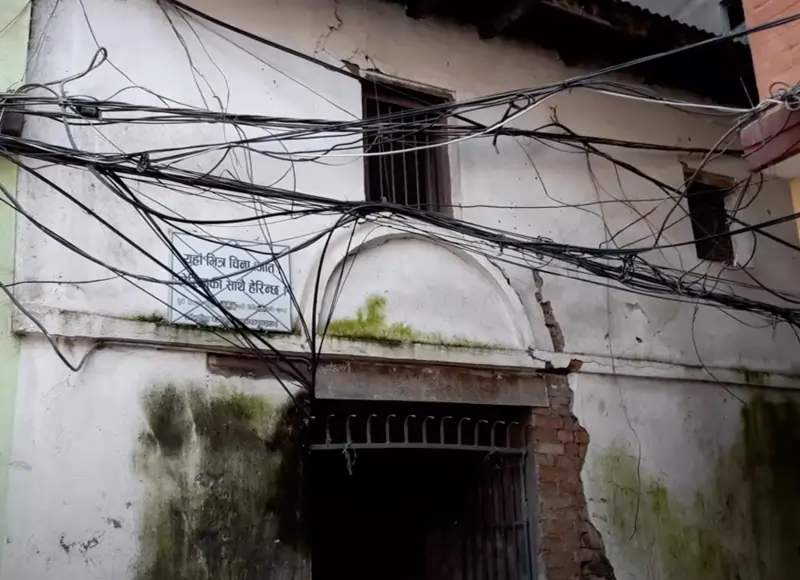
Concluding Tribute
The life and legacy of Manju Bajra Bajracharya (Manju Vajra Vajracharya), widely known as Jamana Gubhaju, continue to inspire and captivate those who hear his story. A figure of immense spiritual power and wisdom, Jamana Gubhaju’s profound mastery of Vajrayana Buddhism and Tantric practices not only earned him the respect of his time but also ensured his lasting influence. From his remarkable acts of compassion to his unparalleled connection with the divine, his life serves as a beacon of humility, dedication, and moral integrity. His extraordinary departure from the physical world, marked by his deep meditation and the belief that his spirit still protects Kathmandu, further cements his status as a timeless guardian. Jamana Gubhaju’s legacy reminds us of the importance of inner strength, self-discipline, and the lasting impact one can have through pure spiritual devotion.
Frequently Asked Questions
1. Who was Manju Bajra Bajracharya, also known as Jamana Gubhaju?
Manju Bajra Bajracharya, famously called Jamana Gubhaju, was a renowned 16th-century Bajracharya priest, Tantric master, and spiritual guide from Kathmandu, Nepal. He was known for his wisdom, mastery of Vajrayana Buddhism, and profound siddhis (spiritual powers).
2. Why is he called Jamana Gubhaju?
The name “Jamana Gubhaju” translates to “the priest who does not eat rice” in Newari. He earned this title from a legend where he vowed to stop eating rice after seeing his wife burn her leg while cooking it. This act of abstinence symbolized his empathy and spiritual discipline.
3. Why is Jamana Gubhaju considered a Tantric?
Tantra means “technique”, and a Tantric is someone who uses techniques to solve problems quickly and effectively. Jamana Gubhaju’s practices and teachings emphasized practical solutions and profound wisdom, qualities akin to a scientist in modern terms. His mastery of rituals, meditations, and spiritual methods showcase his technical and intellectual brilliance.
4. Is it true that Tantrics are magicians or perform supernatural acts?
No, that is a myth often perpetuated by movies and popular media. A Tantric is not a magician but someone who applies methods for practical and spiritual purposes.
5. Why do some people associate Tantrics with fraud or superstition?
Like any field, there are fraudulent individuals who misuse the title for personal gain. This has led to misunderstandings about what Tantrics truly represent.
6. What texts did Jamana Gubhaju write?
He authored several sacred texts in Sanskrit, including:
- Vajra Bhairava Sadhana Nama – A guide for meditating on Vajra Bhairava.
- Tara Devi Stotra Ekavimshati Sadhana – A hymn and practice for the 21 forms of Tara.
- Mahamudra Abhigiti – A poetic exploration of ultimate spiritual realization.
7. What are the sacred songs (Chacha) composed by him?
Jamana Gubhaju composed devotional songs, including:
- Namami – A song of reverence and surrender to the divine.
- Shri Harati – A hymn dedicated to the goddess Harati, set in Bhairavi raga and Trihula tala.
8. What is the legend of the Jyapu Well and Shantipur Temple?
Jamana Gubhaju is believed to have meditated in the Jyapu Well during a drought to seek blessings from Naag Dev, the serpent deity. He discovered an underground connection to Shantipur Temple in Swoyambhu, a mysterious temple with seven doors, which only he could open using his siddhis.
8. How did Jamana Gubhaju’s life end?
He entered a state of deep meditation and instructed his wife not to disturb him. When he did not return, his worried wife opened the door to find him lifeless. Believing he had passed away, she performed his death rites. However, it is believed his soul never departed and continues to protect and guide the people of Kathmandu.
10. What lessons can we learn from Jamana Gubhaju’s life?
His life teaches the importance of humility, empathy, spiritual discipline, and using wisdom and techniques to solve life’s challenges. His legacy as a protector and guide continues to inspire generations.
References
- Prasiddha Bajracharya, Badri Ratna Bajracharya, 1988
- Jamana Gubhaju, Author: Tej Prakash Shrestha, Illustration: Surendra Maharjan, 2017
- Buddhist Monasteries of Nepal, John K. Locke, 1985
- Cover Art of Manju Bajra Bajracharya, Sarad Shakya, Shantipur Magazine Edition 3

